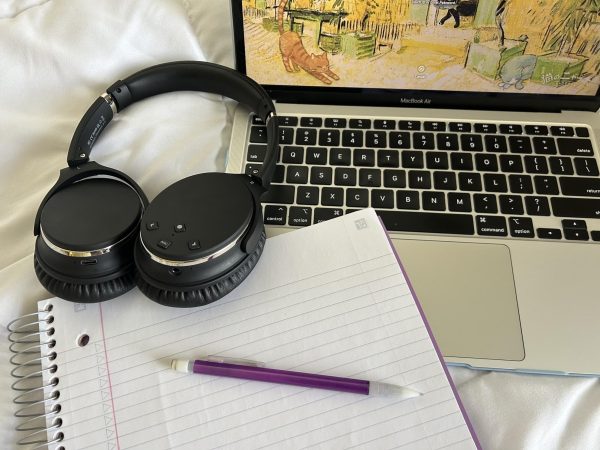High schools face major arts funding cuts
February 1, 2005
Erin Knopsnider, twelfth grade student at Kent Roosevelt High School, works on a drawing Wednesday.
Credit: Beth Rankin
Imagine high school with no art class. No drama class. No music class or marching band.
Although the idea may seem far-fetched, it could become a reality if nationwide trends continue.
Funding for the visual arts, music, theater and dance are losing ground across the country due to a ballooning deficit and legislation that caters to standardized testing, according to a recent Washington Post report.
Compliance with the No Child Left Behind Act, which makes teaching to standardized testing regulatory, is being cited by some in the education field as the main reason why arts funding is on the chopping block as the first sacrifice to be made.
The arts are actually included under the No Child Left Behind Act in new minimum content standards for the fine arts by the Ohio Department of Education for high schools released in September 2004.
Making cuts
At Elyria High School in Lorain County, drama teacher Pamela Christian is feeling the direct effects of funding cuts and a series of failed school levies in their district.
“Those of us not teaching classes affected by the Ohio Graduation Test, specifically the arts, may be cut,” she said. “If we don’t have a large number of students involved in our class then they’ll just cut the class.”
Usually, Christian teaches several sections of drama courses, but now if enrollment falls to less than 20 students, the class will be cut due to new standards — or combined into one very large class.
The Elyria Public Schools recently experienced a $3 million budget cut, forcing layoffs of teachers in extracurricular areas such as the arts and athletics.
Budget constraints
Jami Goldstein, communications manager for the Ohio Arts Council, said she sees the effects of cuts across the board — even in grant money, which is extraneous from high school arts budgets.
Goldstein said the Ohio Arts Council’s 2005 budget was reduced by approximately $720,000 compared to the 2004 budget. This is the council’s fifth reduction in three years. To accommodate the reductions, the Ohio Arts Council also had to make administrative and program reductions.
“We’re really feeling the trickle-down effect of the federal government’s problems,” Goldstein said. “Our philosophy at this point is to hang in there and encourage people to do as much as they can with what they have.”
Not all high schools are facing the hardships like those affecting Elyria’s schools.
At Kent-Roosevelt High School, community support keeps the arts alive.
“We haven’t reduced any of our arts spending,” Principal Roger Sidoti said.
“Through efforts of our assistant superintendent, we brought our arts back to the level they were three years ago.”
Despite the success, Sidoti said the school would like to seek community support to combine all the school’s arts programs under one department. Community funding is necessary, he said, because so many educational grants now stipulate compliance with standardized testing.
A voice of hope
Ohio currently ranks 22nd nationwide in its support of the arts community in legislation, according to the Americans for the Arts Action Fund — overall Ohio received a “B” grade. But with an expected $5 billion statewide deficit proposed by Governor Bob Taft on Jan. 25, cuts are expected across the board.
But Northeast Ohio politicians fared better than the state as a whole when it came to support of the arts. The voting records of state politicians on 11 pieces of legislation were assessed by the Arts Action Fund to tabulate grades for individual politicians.
Portage County Democrat Tim Ryan received the highest statewide grade of “A+”. The other four A’s went to Dennis Kucinich of Cleveland, Stephanie Tubbs-Jones of Cleveland and Marcy Kaptur of Toledo. Steven LaTourette was the only top-scoring Republican.
Making it work
Cuyahoga Falls High School Principal Nick Valentine said legislation is making it difficult to get money for the arts.
“I think some of the legislation out there puts a squeeze on what can be spent on areas that are not testing-related,” he said. “Whether you’re talking about physical education, vocational programs or the arts, overall nationwide there is a cut to the percent of education dollars.”
Valentine said the school does not receive any sort of minimum standards documentation requiring the school to have a certain amount of arts in the curriculum.
The document does exist, said Lorie Owens, English language arts consultant at the Ohio Department of Education.
Owens said the documentation was approved in September 2004 and is in effect in all Ohio schools and in compliance with the No Child Left Behind Act.
But apparently, not all schools are implementing these content standards.
Valentine said Cuyahoga Falls has not had to cut any arts programs yet, but he knows it has happened at other area school districts.
“Basically, when it comes time to cutting, you can cut as deep as you want to go,” he said. “Administrators will only keep those things that are absolutely essential. I think you’re beginning to see that across the board.”
But this might not bode well for the standardized testing model that a core math and science curriculum is aimed at aiding.
Students who participate in arts-related activities statistically outperform their non-arts peers on the SAT, according to reports by the College Entrance Examination Board. In 2002, SAT takers with coursework or experience in music performance scored 57 points higher on the verbal portion of the test and 41 points higher on the math portion than students with no coursework or experience in the arts. Those with coursework in music appreciation achieved scores that were 64 points higher on the verbal and 43 points higher on the math portion.
Contact religion and culture reporter Steven Harbaugh at [email protected].























